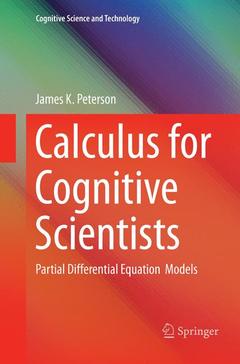Description
Calculus for Cognitive Scientists, 1st ed. 2016
Partial Differential Equation Models
Cognitive Science and Technology Series
Language: English
Calculus for Cognitive Scientists
Publication date: 12-2018
Support: Print on demand
Publication date: 12-2018
Support: Print on demand
Calculus for Cognitive Scientists
Publication date: 02-2016
Support: Print on demand
Publication date: 02-2016
Support: Print on demand
Description
/li>Contents
/li>Biography
/li>Comment
/li>
This book shows cognitive scientists in training how mathematics, computer science and science can be usefully and seamlessly intertwined. It is a follow-up to the first two volumes on mathematics for cognitive scientists, and includes the mathematics and computational tools needed to understand how to compute the terms in the Fourier series expansions that solve the cable equation. The latter is derived from first principles by going back to cellular biology and the relevant biophysics. A detailed discussion of ion movement through cellular membranes, and an explanation of how the equations that govern such ion movement leading to the standard transient cable equation are included. There are also solutions for the cable model using separation of variables, as well an explanation of why Fourier series converge and a description of the implementation of MatLab tools to compute the solutions. Finally, the standard Hodgkin - Huxley model is developed for an excitable neuron and is solved using MatLab.
Introduction.- Graham - Schmidt Orthogonalization.- Numerical Differential Equations.- Biological Molecules.- Ion Movement.- Lumped and Distributed Cell Models.- Time Independent Solutions to Infinite Cables.- Time Independent Solutions to Finite and Half-Infinite Space Cables.- A Primer On Series Solutions.- Linear Partial Differential Equations.- Simplified Dendrite - Soma – Axon Information Processing.- The Basic Hodgkin - Huxley Model.- Final Thoughts.- Background Reading.
Dr. James Peterson is an Associate Professor in Mathematical Sciences and Biological Sciences at Clemson University, USA. His formal training is in mathematics but he has worked as an aerospace engineer and a software engineer also. He enjoys working on very hard problems that require multiple disciplines to make sense out of and he reads, studies and plays in cutting edge areas a lot as part of his interests.
Derives the cable equation and the Hodgkin Huxley models for excitatory neurons from first principles of biophysics
Highlights theoretical and computational tools to enhance understanding of both the underlying science and the solutions
Provides insights into the theory and computation of the underlying cognitive and biological science models that are studied
Includes supplementary material: sn.pub/extras
© 2024 LAVOISIER S.A.S.




